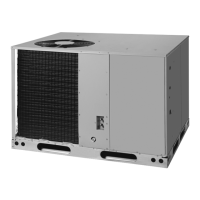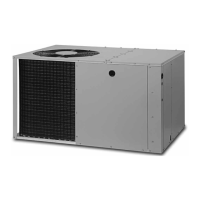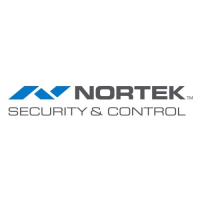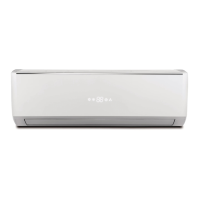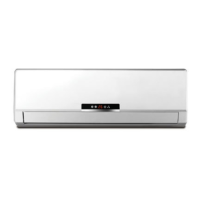9
represent the time elapsed before defrosting cycle starts
and they are dependent on the climate conditions of the
installation. A 30 minute setting would be recommended
in a moist climate such as Seattle Washington. A 90
minute setting would be adequate in a dry climate such
as southern Arizona. The factory time interval setting is
30 minutes.
Defrost Control Board
Operational Information
• Terminals R - C must have 24V present between
them for the time delay and defrost sequences to be
operational.
• Defrost Thermostat (DFT) By-Pass - Jumping the
T2 & DFT test pins will communicate to the board that
the defrost thermostat is closed (if the compressor is
running). The defrost T-stat tells the board whether a
defrost cycle needs to be started or terminated.
NOTE: The defrost T-stat is closed at 30° F or below
and is open at 68° F or above, but its state is unknown
if the temperature is between 30° F and 68° F.
• With the DFT closed, the unit will run for 30/60/90
minutes in heat mode and then defrost the outdoor
coil. The defrost will turn off the outdoor fan, energize
the reversing valve, and turn on the compressor raising
the coil temperature to 68° F. This will open the DFT
and terminate the defrost. If the DFT does not open,
the defrost will end after 10 minutes.
• Defrost Board Speed Up - Jumping the TEST terminal
to the C (common) terminal (while the compressor is in
heat mode) will over-ride the defrost board and initiate a
faster defrost test in 5, 10 or 15 seconds as determined
by the 30, 60 or 90 minute defrost pin settings (factory
setting is 30 minutes).
– The compressor off delay is also bypassed when the
unit goes into defrost test. If unit is kept in defrost
test, the delay will be bypassed when the test is
terminated by the processor.
NOTE: If the jumper is removed before the test is over,
the processor will perform the remainder of a normal
defrost as noted above.
• The delay/no-delay pin affects compressor operation
during defrosts. The default setting is delay. To switch
from delay to no-delay, remove the pin from the delay
pin location and move it to the no-delay pin location.
- Scroll compressors that have noise issues while
going into or coming out of defrost should use this
30 second delay to reduce the defrost noise.
Normal Mode
To test normal defrost operation when the temperature is
above 35° F, jumper R to DFT on the board and allow the
unit to run for 30 minutes. Defrost will continue until the
R to DFT jumper is removed or for 10 minutes. Remove
the jumper.
The 5 minute time delay feature can be shortened 1 time
to 1 second by jumping the Test to C terminal. Remove
the jumper and repeat as desired. NOTE: If jumper is left
on the Test to common pins permanently, the defrost
cycle will be inoperable.
Speed Up Mode (Testing Procedure)
1. Jumper T2 to DFT at the test terminals.
2. With unit running in heat mode, jump the TEST terminal
to the C (common) terminal near it. The board will
speed up and enter defrost mode in 5/10/15 seconds,
depending on the defrost time selection. Compressor
delay will not function during speed-up. NOTE: Manually
initiating a defrost will cause the compressor to run
continually when entering defrost.
3. This test will end in 5 seconds if the TEST - common
short is not removed.
4. Remove both the short and the T2 to DFT jumper to
terminate the defrost cycle. The 30 second compressor
delay should operate normally.
5. Test is complete, reset thermostat to the equipment
owner’s preference.
Electric Heat Package (optional)
This heat pump is shipped without an auxiliary electric
heat kit installed. If electric heat is desired, an accessory
heater kit must be field installed. Refer to Table 2 (page
10) for blower speeds.
• Selectthecorrectsizeheatpackagefortheinstallation.
See specifications sheet for available kits and application.
Install the heater kit according to the to the installation
instructions provided with the kit.
• Installationismosteasilyaccomplishedbeforemaking
duct or electrical connections.
Outdoor Thermostat (Factory Option)
The outdoor thermostat prevents the electrical auxillary
heat (if used) from operating above a desired set point.
The factory temperature setting is 40°
F.

